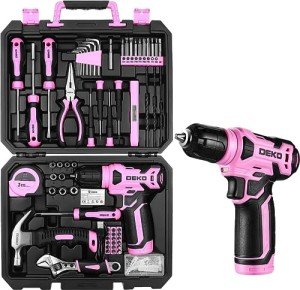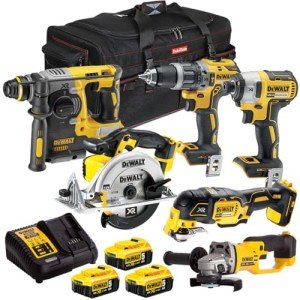
Build Your Own Cordless Power Tool Kit
Add a review FollowOverview
-
Sectors Developers
-
Posted Jobs 0
-
Viewed 200
Company Description
Tool Kit Builder Techniques To Simplify Your Everyday Lifethe Only Tool Kit Builder Trick That Everybody Should Know
The Essential Tool Kit Builder: Crafting Your Ultimate Toolkit for Success
In any occupation or hobby, having the right tools can make all the difference. From building and construction to art, education to tech startups, a sound toolkit not just assists in accomplishing jobs effectively but also improves creativity and productivity. In this post, we will check out the aspects of a great tool kit, how to build one tailored to your particular needs, and resolve some regularly asked questions relating to tool kit building.
Why Building a Tool Kit is Essential
A tool kit, despite the context, serves as a curated collection of resources that streamline procedures, fix issues, and raise results. The following table describes the benefits of having a well-structured tool kit:
| Benefits of a Tool Kit | Description |
|---|---|
| Performance | Lowers time spent looking for tools or resources. |
| Quality | Boosts the quality of output through best-in-class tools. |
| Development | Fosters imagination by offering varied resources. |
| Ease of access | Centralizes everything in one place, making it easy to access required tools anytime. |
| Ability Development | Encourages learning new techniques and enhancing existing abilities through varied tools. |
Actions to Build Your Tool Kit
Developing a tool kit involves examining your requirements, investigating possible tools, and arranging them efficiently. Here’s a structured method:
1. Determine Your Goals
Start with a clear understanding of what you wish to accomplish with your tool kit. List your short-term and long-lasting objectives:
- Short-Term: What instant tasks will the toolkit help in?
- Long-Term: What skills or projects may it help establish in the future?
2. Examine Your Current Tools
Evaluation any existing tools you have. Recognize gaps and locations for improvement. Produce a table to compare what you have versus what you need.
| Existing Tools | Spaces | Prospective Tools Needed |
|---|---|---|
| Hammers | Missing a sledgehammer | Sledgehammer |
| Screwdrivers | No accuracy screwdrivers | Accuracy screwdriver set |
| Paintbrushes | Restricted sizes | Range of paintbrush sizes |
3. Research study
Investigate and collect information on different tools that fit the needs you’ve determined. Consider quality, resilience, and user reviews.
4. Classify Tools
When you have a detailed list, classify your tools based upon their usage. Typical categories may include:
- Basic Tools: Hammers, screwdrivers, pliers
- Power Tools: Drills, saws, sanders
- Specialty Tools: Laser levels, woodworking jigs
- Digital Tools: Software platforms, apps, online resources
5. Arrange and Store
Create a storage solution for your tool kit. This can range from a toolbox with compartments to cloud storage for digital tools. Organizing tools effectively can boost your performance. Here are some storage services:
| Storage Solution | Advantages | Best For |
|---|---|---|
| Tool kit | Portable, secure | Physical tools |
| Wall-mounted racks | Space-saving, shows tools | Workshops, garages |
| Cloud storage services | Remotely available, collective | Digital tools and documents |
6. Review and Update Regularly
A tool kit is not a static entity. Routinely examining and updating your toolkit can help you stay current with trends and technologies.

Example Toolkit for Various Fields
To give you a clearer idea of what a tool kit could appear like in practice, here are examples for three unique professions:
1. A Teacher’s Toolkit
| Tool | Function |
|---|---|
| Whiteboard markers | Mentor and conceptualizing |
| Projector | Visual presentations and multimedia |
| Classroom apps | Interactive learning and evaluations |
| Organizational tools | Lesson planning and tracking |
2. A DIY Home Improvement Kit
| tool kit builder | Purpose |
|---|---|
| Cordless drill | Easy setup and assembly |
| Level | Making sure straight lines and accuracy |
| Tape procedure | Exact measurements |
| Paint supplies | Visual updates to areas |
3. A Digital Marketer’s Toolkit
| Tool | Purpose |
|---|---|
| SEO software | Optimizing website visibility |
| Social media management tools | Scheduling and tracking posts |
| Content production tools | Designing captivating visuals |
| Analytics software | Determining efficiency and ROI |
Frequently Asked Questions (FAQ)
Q1: How typically should I update my tool kit?
A: It is recommended to examine your tool kit regularly– at least when or twice a year– depending on changes in your field or developments in innovation.
Q2: Can a tool kit be both physical and digital?
A: Absolutely! Numerous experts integrate both physical and digital tools to maximize their effectiveness in numerous tasks.

Q3: How do I decide which tools are important for my toolkit?
A: Prioritize tools based upon your goals and requirements. Research study and look for recommendations from skilled experts in your industry.
Q4: Is it necessary to invest in high-end tools?
A: While high-end tools typically use better resilience and efficiency, you do not constantly require the most pricey alternatives. Evaluate quality through evaluations and consider mid-range tools if you’re on a spending plan.
Q5: Can I customize my tool kit with time?
A: Yes! A tool kit should develop based on your growing skills, altering requirements, and improvements in innovation.
Building an effective tool kit can be a transformative undertaking, no matter the field. By tactically collecting tools, organizing them effectively, and routinely updating your selections, you can develop a reliable resource that improves your professional or personal undertakings. Whether you are an instructor, a home DIYer, or a digital marketing professional, a durable toolkit is vital for accomplishing your goals and surpassing expectations. Start the procedure today towards crafting your own optimal tool kit and view your imagination and productivity soar.



